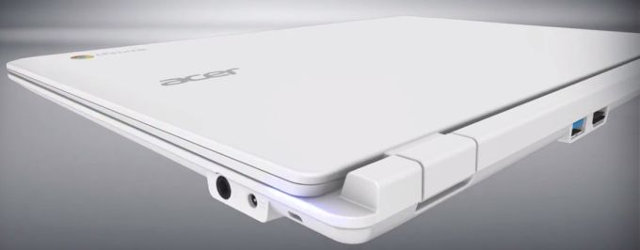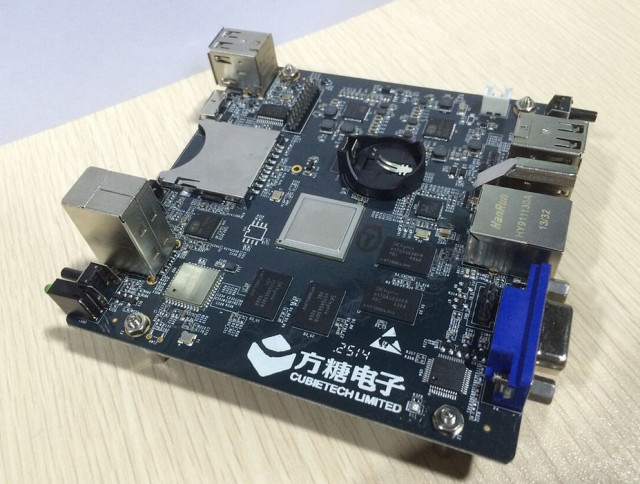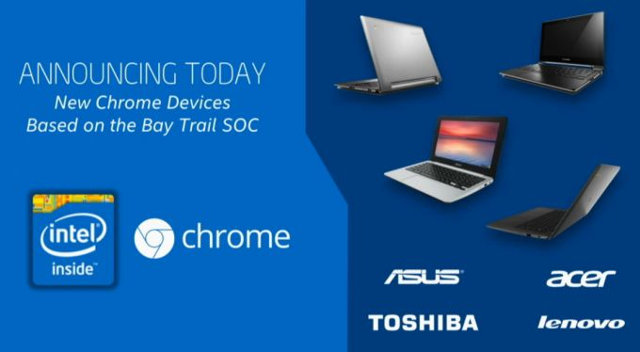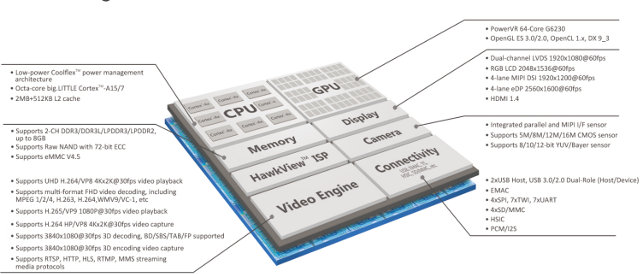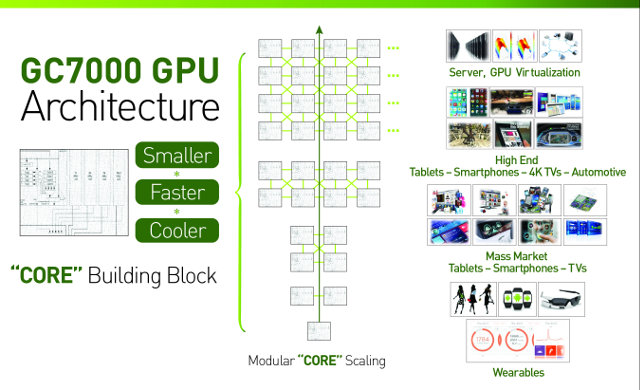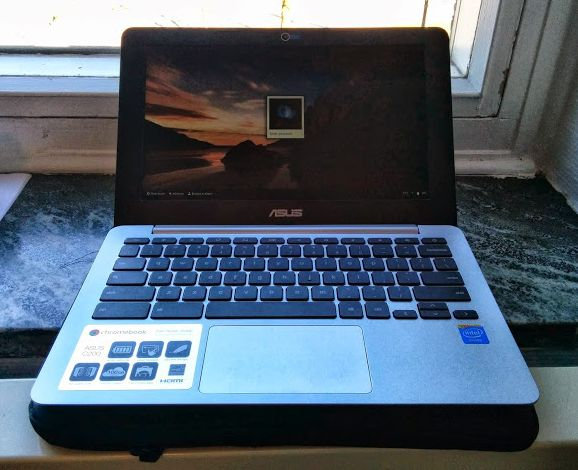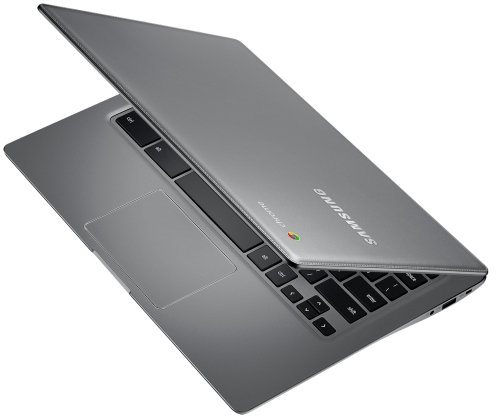It seems Nvidia Tegra K1 is getting in more hardware than its predessors. It can not only be found in Jetson TK1 development board and Shield tablet developed by the company, but also products such as Xiaomi MiPad, as well as Google Tango Project Tablet devkit. Acer CB5 Chromebook should also launch very soon with Tegra K1 quad core processor, a 13.3″ display, and the company claims it should last 13 hours based on Google’s power_loadtest. Preliminary specs for Acer CB5 Chromebook: SoC- Nvidia Tegra K1 quad core Cortex A15 @ 2.1 GHz with Kepler GPU System Memory – 2 to 4 GB DDR3 Storage – 16 / 32 GB flash Display – 13.3″ display with 1366×768 or 1920×1080 resolution (TBC) depending on model, and optional touchscreen support Video Output – HDMI Audio – 3.5mm audio jack, speakers Connectivity – 802.11 b/g/n/ac Wi-Fi USB – 2x USB 3.0 ports, 1x […]
Pictures and Specs for CubieBoard 8 Development Board Powered by AllWinner A80 SoC
Back in April, AllWinner announced partnerships with Linksprite and CubieTech for respectively PcDuino 8 and Cubieboard 8 development boards to feature AllWinner A80 octa core ARM Cortex 15/A7 big.little SoC. However, at the time all we got was some photo-shopped pictures of older versions of the boards with an A80 processor pasted by graphics designers. Some pictures of Cubieboard 8 have now surfaced, and they are clear enough so that we can start to get most of the specs. Here are Cubieboard 8 specifications derived from the pictures (incomplete because we don’t have pictures of the back of the board): SoC – AllWinner A80 octa core big.LITTLE processor with 4 ARM Cortex A15 cores, 4 Cortex A7 cores, and Imagination PowerVR G6200 GPU System Memory – 2GB DDR3 (4x SKhynix H5TQ4G83AFR – 4Gbit RAM chips) – TBC in case they’ve added more RAM chips at the back, unlikely IMHO. Storage […]
ARM Cortex A15/A17 SoCs Comparison – Nvidia Tegra K1 vs Samsung Exynos 5422 vs Rockchip RK3288 vs AllWinner A80
We’re now starting to get quite a few players with ARM Cortex A15 cores on the market, as well as some with ARM Cortex A17. So a comparison table of different quad and octa SoCs might be a useful thing to do. I’ve put aside SoCs such as HiSilicon K3V3, and OMAP5, and focused on the four latest processors: Nvidia Tegra K1 (32-bit), Samsung Exynos 5422, Rockchip RK3288 and AllWinner A80. I haven’t included Mediatek MT6595 and Qualcomm SnapDragon 805, because the two companies mainly focus on smartphones and tablets (although it appears to be slowly changing for Qualcomm), documentation is usually difficult or impossible to find, and in the case of Qualcomm they use their own ARMv7 Krait cores. I’ve highlighted some features in green, in case a particular SoC appears to have an edge. Rockchip RK3288 AllWinner A80 Nvidia Tegra K1 Samsung Exynos 5422 CPU 4x ARM Cortex-A17 […]
Intel based Chromebooks Announcements Galore By Acer, Asus, Dell, Lenovo and More
Yesterday, Intel and Intel had a press event about Chrome OS devices where Google discussed the success of Chrome OS, and Intel showed existing and upcoming Chromebooks based on Haswell and Bay Trail processors. After a short introduction by Intel, Google took the stage to discuss the commercial success of Chromebooks which are now found in 10,000 schools, and are among the best selling and best rated laptops on Amazon, as well as key advantages and features of Chrome OS: fast boot, new version every 6 weeks, and after offline support for google docs, soon offline support for video playback. Intel then continued by showing off some existing Haswell Chromebooks, a new HP Chromebox to become available in June, and LG All-in-One Chromebase with a 22″ display, Haswell Celeron 2955U processor, 2GB RAM, and 16GB SDD to sell later this month for $349. The company took a break from product announcement […]
AllWinner A80 To Support 5 Operating Systems, Products To Become Available in May
AllWinner has released some more materials about their AllWinner A80 Ultracore octa core big.LITTLE SoC ahead of the Hong Kong Electronics Fair 2014, and we’ve learned more about OptimusBoard, as well as tablets and TV boxes availability through a video interview shot by Charbax at the exhibition. Part of the release was more detailed specifications: CPU Octa-Core big.LITTLE Cortex-A15/7 Low-power CoolFlex power management architecture 2MB + 512 KB L2 Cache GPU – Imagination Technologies PowerVR 64-core G6230 with support for OpenGL ES 3.0/2.0, OpenCL 1.x, RenderScript, DX 9.3/10.0 Memory Supports dual-channel DDR3/DDR3L/LPDDR3/LPDDR2, up to 8GB Supports Raw NAND with 72-bit ECC Supports eMMC V4.5 Video Supports UHD H.264/VP8 4Kx2K@30fps video playback Supports multi-format FHD video decoding, including MPEG 1/2/4, H.263, H.264. WMV9/VC-1, etc Supports H.265/VP9 1080p@30fps video playback Supports H.264 HP/VP8 4Kx2K@30fps video capture Supports 3840×1080@30fps 3D decoding, BD/SBS/TAB/FP supported Supports 3840×1080@30fps 3D encoding Supports RTSP, HTTP, HLS, RTMP, MMS […]
Vivante Unveils Details About GC7000 Series GPU IP Family
Earlier this month, Vivante Corporation has announced several silicon partner integrations (but no names given) of its GC7000 Series GPU IP into SoCs targeting wearables, mobile, automotive, and 4K TV products, and provided some more details about its GC7000 family which supports features such as OpenGL ES 3.1 API, and hardware TS/GS/CS (tessellation / geometry / compute shader) extensions for Android. According to the company, they key benefits of their GC7000 GPU IP can be summarized as follows: True GPU Scalability – GC7000 Series products support limited silicon area to match form factor and market requirements. Products can snap to grid starting at 3.0 mm2 (28 nm) for the smallest single GPU GC7000 instance and grow in simple modular fashion for high end implementations to achieve what the company’s claims to be the the industry’s best PPA (power/performance/area). Smallest Licensable OpenGL ES 3.1 Cores with Geometry, Tessellation, and Compute Shaders […]
Asus C200 & C300 Chromebooks Feature Intel N2830 “Bay Trail-M” SoCs
Asus is about to launch two ChomeBooks, Asus C200 Chromebook and C300 Chromebook, for respectively around $250 and $350 according to listing from various online retailers, as NetbookItalia has recently reported. Let’s go through the specs available for both laptops. These are unconfirmed and incomplete, as I just gathered some information from multiple sites. Asus C200 Chromebook: SoC – Intel Celeron N2830 dual core processor @ 2.16 Ghz (Burst mode: 2.41 GHz ) with Intel HD graphics up to 750 MHz. (7.5 W TDP). System Memory – 2GB RAM Storage – 16 GB eMMC Display – 11.6″ display (1366×768) Connectivity – Wi-Fi 802.11n, Bluetooth 4.0 USB – 1x USB 2.0 port, 1x USB 3.0 port Video Output – HDMI port Webcam – HD Battery – 48WHrs, 3S1P, 3-cell Li-ion Polymer Battery Pack up to 10 hours Weight – 1.15kg There appears to be at least three variants, namely C200MA-EDU, C200MA-DS01 and […]
Samsung Chromebook 2 Features Exynos 5 Octa SoC, Comes with either 11.6″ or 13.3″ Display
Samsung has just launched the Chromebook 2 Series with two models based on on Exynos 5 Octa SoC, available in 11.6″ (1366×768) and 13.3″ (1920×1080) configurations, and featuring 4GB RAM, 16GB eMMC, and a longer battery life thanks partially to big.LITTLE processing technology. Samsung expects the new Chromebooks to be used for work, education, and entertainment. Thanks to strong hardware specifications, these new ARM based Chromebooks will certainly offer performance similar to, or even outperforming, existing many Intel Celeron based Chromebooks, and at the same time offer a longer battery life. It’s a nice upgrade to the Exynos 5250 powered Chromebook launched in 2012, especially the addition of a model with a 13.3″ display with FHD resolution. The 13.3″ model has an Exynos 5 Octa processor clocked at 2.1GHz which should be the latest Exynos 5422, whereas the 11.6″ model might use Exynos 5420 instead (TBC). The company also mention […]


